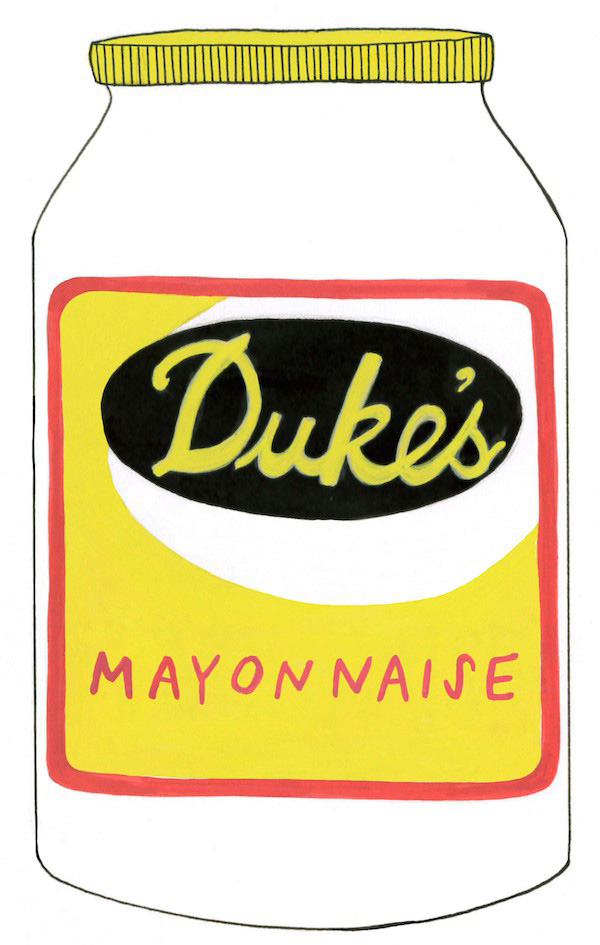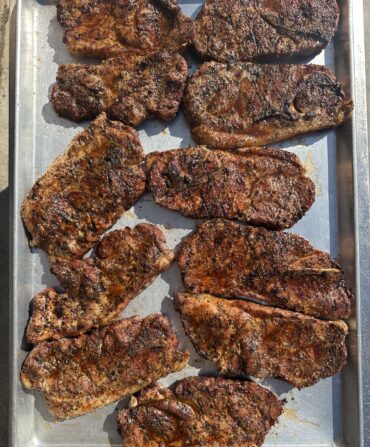In many of the most popular restaurants below the Mason-Dixon line today, diners can practically trace the sprigs of parsley garnishing their plates to the wholesome hands of local farmers. So it’s surprising when the same chefs who preach about heirloom seeds and heritage animals embrace a factory-made food. But one variety of mayonnaise still arrives at upscale kitchens from Texas to Tennessee in decidedly non-artisan plastic tubs.
Duke’s mayonnaise has been a staple below the Mason-Dixon line for ninety-eight years, and some combination of nostalgia and genuine appreciation keeps it in refrigerators all over its native range. With tomato sandwich season in full swing, we asked a handful of experienced culinarians why it deserves such a hallowed place in the regional pantry.

Photo: Johnny Autry
A tomato sandwich with Duke’s.
“It’s one of only two completely prefabricated products that we buy. Duke’s mayonnaise and Heinz ketchup, and that’s it. I was raised in a home where it was the only mayo, and I love the creaminess and versatility of it. It’s really fatty, but with the perfect amount of tang. When we make a burger, we use Duke’s. Same for BLTs, bologna sandwiches, and even chocolate cake and biscuit batter.”
—David Bancroft, Acre, Auburn, Alabama
“People assume I grew up with it, but I didn’t actually discover it until sometime around 2001, when I moved to Richmond. [Chef] Walter Bundy wouldn’t shut up about it, and I was like, ‘What’s the big deal?’ I realized at that moment it was like a religion. And there was something different about it. I thought it had extra vinegar, and then I did some research and I found out that the difference is that it has no added sugar. So it seems like it’s more acidic and balanced than other store-bought mayonnaises. When you make your first tomato sandwich with it, that flavor is locked into your brain, and every time you make mayonnaise you’re chasing that flavor. And then you wonder, ‘Why am I even making my own mayonnaise?’ I haven’t made mayonnaise in ten years.”
—Sean Brock, Husk, McCrady’s, and Minero, Charleston, South Carolina, and Nashville, Tennessee

“It’s the mouthfeel, it’s the flavor. It has a citrus note to it that you don’t normally get in factory-produced mayonnaise. I think chefs like it because it’s not sweet like a lot of the other shelf-stable mayonnaises.”
—John Currence, City Grocery, Snackbar, and other restaurants in Oxford, Mississippi, and Birmingham, Alabama
“Here’s a secret admission: I don’t particularly care for mayonnaise. This is a personal opinion, and it’s not applied at the restaurant. I think one of the reasons is that my parents were Hellman’s people, so my early years were spent in the presence of a subpar mayonnaise. We use Duke’s at the restaurant, and we have a little four-ounce jar at the house, just in case. It has more acid, more tang. It has a brightness that makes other things taste better.”
—John Fleer, Rhubarb, Asheville, North Carolina
“I’m a homemade mayonnaise guy, but there are certain brands in the food world that I just trust. White Lily flour, Duke’s mayonnaise, Crystal and Tabasco hot sauces. From a mayonnaise standpoint, it has amazing balance between fat and acid. The flavor is the best of any store-bought mayonnaise. Texture-wise, it has a stability that you just don’t get with homemade. It holds pimento cheese and chicken salad together with a velvety softness, and it doesn’t fall apart under heat.”
—Linton Hopkins, Restaurant Eugene, Holeman & Finch, and other restaurants in Atlanta, Georgia
“This actually sparked a heated debate in my kitchen. [Fiancé and cooking partner] Ben was saying, ‘My grandma always had Duke’s.’ Another cook said, ‘Well, my grandma had Hellman’s.’ I think it comes down to the grandmas.”
—Whitney Otawka, Greyfield Inn, Cumberland Island, Georgia








